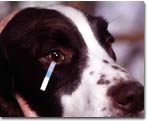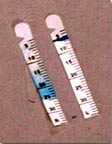|
Keratoconjunctivitis sicca. (KCS) is the
technical term for a condition also known as "dry eye." Inadequate tear
production is the cause. This may be due to injuries to the tear glands, such as
infections or trauma. The nerves of these glands may also become damaged. Eye infections
and reactions to drugs such as sulfonamides can impair the nerves and/or the glands. Some
cases are also the result of the gland of the third eyelid being surgically removed by
mistake. Many cases have no known cruise; the glands simply cease to function at their
normal levels.
What are the
symptoms?
The eyes typically develop a thick, yellowish
discharge. Infections are common as the lack of the bactericidal tears allows bacterial
organisms to overgrow on the eye. Additionally, inadequate lubrication allows dust,
pollen, etc., to accumulate. As a result the eyes lose their ability to flush away foreign
particles and protect themselves from bacteria. To confirm a case of dry eye, a
measurement of tear production is performed. Veterinarians use a small piece of absorbent
material called a Schirmer tear test strip. This small strip is placed in the eye. Over a
period of usually one minute, the tears soak: and migrate tip the strip. The wet area of
the strip is then measured and compared to normal values. If inadequate tear production if
found, then dry eye is diagnosed
Wheat are the risks?
Left untreated, the patient will suffer painful
and chronic eye infections. Repeated irritation of the cornea results in severe scarring
which will become apparent. Corneal ulceration may develop, and will lead to blindness.
What is the
management?
If the cause can be identified, treatment
should be aimed at eliminating it. An evaluation to determine infection should be
performed. A thorough history may reveal past infections that could have damaged the tear
glands or their nerves. If the patient is receiving sulfa drugs, they should be stopped at
once. From our clinical experience, it is very rare that the cause can be identified, in
which case therapy is aimed at replacing tears rather than correcting the cause.
Artifical tear solutions available for humans and sold in
pharmacies can be used in canines. Depending on the severity, these drops are placed in
the eyes at regular intervals throughout the day. These artifical tears provide the needed
lubrication and flushing for the corneas. Antibiotic preparations are often used
simultaneously to provide protection from bacterial organisms. Recently drugs such as
Cyclosporine have been utilized to actually stimulate more tear production. The use of
Cyclosporine has been quite successful in the management, of this disorder.
In very severe cases, a surgery can be performed which transplants
a salivary duct into the upper eyelid area. Saliva then drains into the eye, providing
lubrication. This procedure is rarely used, but is an option.
 Veterinarians
use a small piece of absorbent material called a Schirmer tear test strip to help in
measuring tear production. This small strip is placed inside the lower eyelid. Over a
measured period of time, usually one minute, the tears soak and migrate up the strip. The
wet area of the strip is then measured and compared to normal values. Veterinarians
use a small piece of absorbent material called a Schirmer tear test strip to help in
measuring tear production. This small strip is placed inside the lower eyelid. Over a
measured period of time, usually one minute, the tears soak and migrate up the strip. The
wet area of the strip is then measured and compared to normal values.
 Abnormal tear production with the associated
signs of a red eye with a lot of discharge can occur in several diseases. Abnormal tear production with the associated
signs of a red eye with a lot of discharge can occur in several diseases.
© 2000 Drs. Foster & Smith, Inc.
Reprinted as a courtesy and with permission from PetEducation.com (http://www.PetEducation.com)
On-line store at http://www.DrsFosterSmith.com
Free pet supply catalog: 1-800-323-4208
|  Keratoconjunctivitis Sicca
Keratoconjunctivitis Sicca
![]()